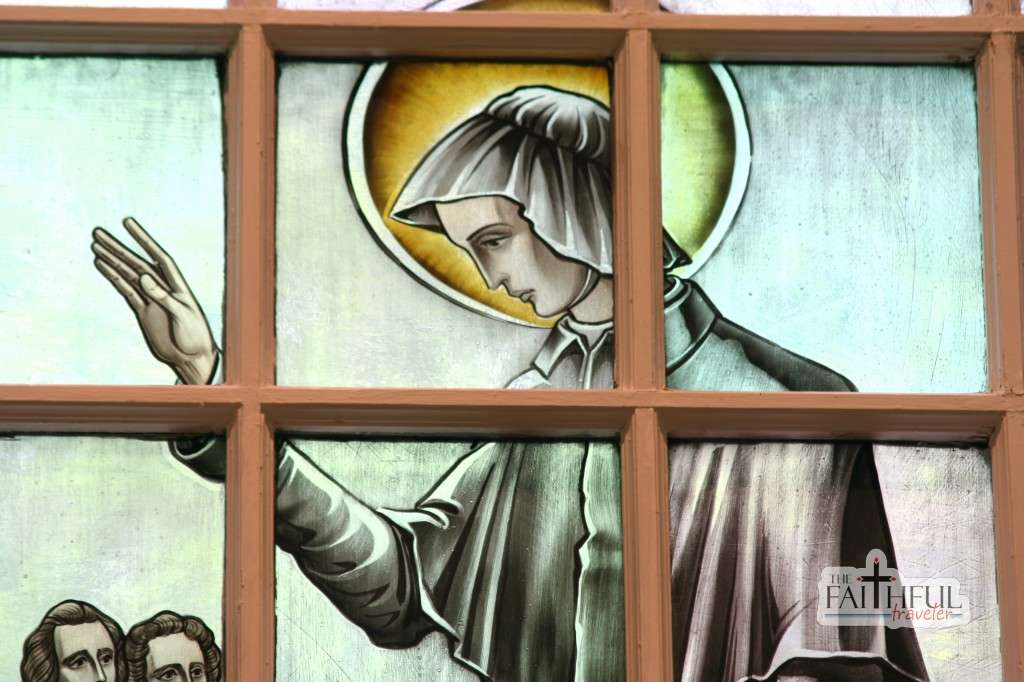 Today, Episode 3 of The Faithful Traveler airs, and in this episode, we visit two locations, both associated with St. Elizabeth Ann Seton, the country’s first canonized saint. Pretty cool that it was a woman, huh? But this woman was no ordinary woman. She absolutely rocked–doing so many things in her short lifetime, she’s sure to have done something that might tie her to our own lives.
Today, Episode 3 of The Faithful Traveler airs, and in this episode, we visit two locations, both associated with St. Elizabeth Ann Seton, the country’s first canonized saint. Pretty cool that it was a woman, huh? But this woman was no ordinary woman. She absolutely rocked–doing so many things in her short lifetime, she’s sure to have done something that might tie her to our own lives.
Elizabeth Ann Bayley Seton had a hard, hard, life, and one of the things I love about her life is that it’s proof that having faith in God doesn’t necessarily mean that your life will be blessed with peace and prosperity. Why is that a good thing? Well, because it’s REAL. It’s only in movies that people who suddenly change their lives of vice into lives of virtue suddenly get the girl, get the job, get the money, etc. In real life, it isn’t so simple. And if you really pay attention to what Jesus says in the Gospels, this should be no surprise. Life is hard. Period. But faith can definitely make weathering the storm more worthwhile and somewhat easier.
But, first, let’s talk about St. Elizabeth Ann. There are a few books about her life out there. Some of them are overly romanticized, overly fanciful. I read a few of those. But, according to Sister Betty Ann McNeil, the very knowledgeable and helpful Provincial archivist of the Daughters of Charity, Province of Emmitsburg, the best book to read on her life is A Definitive Life of Elizabeth Bayley Seton, by Annabelle M. Melville. The book is currently out of print, but not difficult to find on Alibris or Amazon. Still, I think the sisters are trying to reprint the book, so keep an eye out for it if you can’t find a used copy.
Elizabeth Ann Bayley (her maiden name) was born right around the time of the first Continental Congress, as the American colonies were starting to grow impatient with their British monarch. It was a time of change, but also there were a lot of old school beliefs in the colonies that affected her later on in life. Her mother and little sister died when she and her older sister were still young (Elizabeth was 3). Her father was a very prominent doctor who was just too busy with his medicine to care after his daughters–men didn’t do that back then, anyway. So, he married another woman who proved to be the archetypal stepmother to Elizabeth and her sister. She wasn’t too fond of them, they weren’t her kids, so whenever she could, she shipped them off to stay with other family members while she cared for her biological kids. So sad.
You’d think, because of this less-than-ideal family life, that Elizabeth Ann might grow up to be bitter, might think she’d never have kids of her own. But, by the grace of God I think, she didn’t. Instead, she just grew in her faith–she was baptized Episcopalian and she attended services at Grace Church near Wall Street and at St Paul’s Chapel near today’s Ground Zero. Since her own parents weren’t around much for her, she trusted that her Heavenly Father would watch out for her, and He definitely did.
She married William Magee Seton, and they had five kids. Their marriage seems to have been filled with much love. They lived in a house on State Street in NYC, right across the street from today’s Battery Park. Here’s a cool fact–when they lived there, Battery Park didn’t exist!! It was built later. The sidewalk out in front of the house was actually where Manhattan island ended.
Today, Our Lady of the Rosary Parish exists where the Seton household used to be. While the house was torn down some time ago, it’s the same land. Next door is the Watson House, a house that has its own history, associated with helping young Irish women make a life in NYC.
But, William’s family was prone to tuberculosis, and it was this illness that eventually took his life. Just before he died, Elizabeth, William, and their oldest daughter, Anna, took a trip to Italy, hoping that the sea air and Italy’s warm climate might help William’s tuberculosis go away. Instead, when they arrived in Italy, they were forced to stay in a quarantine for a month–the yellow fever epidemics were rampant in NYC at that time, and the Italians didn’t want to take any chances. William died right before Christmas. Elizabeth was suddenly a widow and a single mother of five.
During her time in Italy, she encountered the Catholic faith in full force. She was staying with some of William’s business friends–the Fillicchis–and they did their best to teach Elizabeth about their faith. At that time, Catholicism was not too welcome in the new United States. There are a few reasons behind this–first of all, many American pilgrims were Protestants who came to America to flee anti-Protestant persecution in Catholic countries. So it’s understandable that they had issues with Catholics and what Catholicism meant for them.
Then there were the “Nativists”, who were angry at all the Catholic immigrants from Italy, Germany, Spain, and Ireland for taking jobs and space. You know, the usual anti-immigrant argument. While I can understand how the Protestants might have felt at this time, I have a hard time buying this latter point of view. First of all, I’m the daughter of Mexican immigrants, so this is a matter that is close to my heart. Secondly, aren’t all of us–except the REAL Native Americans–daughters and sons of some immigrant in our lineage? We ALL came here from someone who came from somewhere else.
ANYWAY…
In Italy, Elizabeth Ann learned a few things about Catholicism that she didn’t know before–namely, the dogma of transubstantiation–the Catholic belief that the bread and wine actually become the Body and Blood of Christ during the Mass (as opposed to being a mere symbol). She also learned more about the Blessed Mother, and she found out that Catholics could receive Communion every day!! This was a big deal for Elizabeth, who REALLY was growing closer to God with every new tragedy and joy that her life brought. And the idea of having a Heavenly Mother, too! Well, that was just awesome.
But becoming Catholic wasn’t something that would be easy for Elizabeth. She knew that if she became a Catholic, most of her family and friends would turn on her (which they did). It was NOT an easy decision. But then again, we were never promised a rose garden here on Earth, were we?
She received her First Holy Communion at St Peter’s Catholic Church in NYC, which we visit in this episode, as well. It’s a beautiful church, with Eucharistic Adoration almost every day!! If you’re in NYC, definitely visit this church. It could use a few coats of paint, but overall, it’s a beautiful and historic site. Venerable Pierre Toussaint was also a parishioner here, as were all of the early NYC Catholics. It was, after all, the city’s first Catholic Church.
Eventually, Elizabeth moved to Maryland where she could live life as a Catholic in peace. Of course, life didn’t get easier. More of her family members died–one by one. She suffered greatly, but she continued to cling to the Cross of Christ, knowing that that was where she received her strength to go on. She founded the country’s first community of women–the Sisters of Charity of St. Joseph’s. They adopted the Rules of Life of the Daughters of Charity, a Society of Apostolic Life created by SS. Vincent De Paul and Louise de Marillac.
And today, she is the country’s first canonized saint.
In Episode 5, we visit two locations in Maryland where she lived: St. Mary’s Spiritual Center & Historic Site on Paca Street and the National Shrine of St. Elizabeth Ann Seton in Emmitsburg. Both are VERY cool!
Can you tell there is a LOT to say about this saint? And if you want to read more about our own trails and tribulations in shooting this particular episode, check out my earlier blog post, “When God Demands A Do-Over”. Another reminder that just because you are doing something for God, doesn’t necessarily mean that it’s all going to be honky dory, and everything is going to be easy. Life is hard. Trusting in God makes it somewhat easier, but that doesn’t mean that you don’t get curve balls every now and then!!
Anyway, enjoy the show! Let us know what you think! And don’t forget, that if you like the music we use on this episode, you can find out more about it here.

